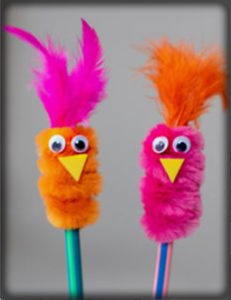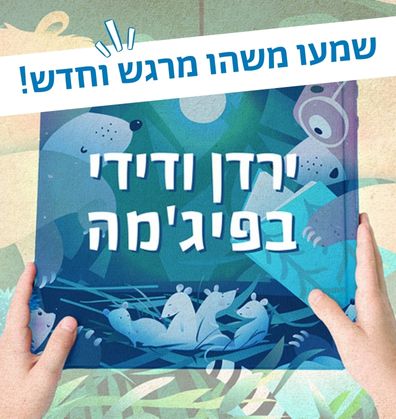סְּפָרִים
Book-Related Family Activities
A discussion on reeds and cedars
You may enjoy discussing flexibility and stability in life. You may want to share examples from everyday life. Situations in which we behave like cedars, rooted in our positions, or situations in which we are agile, changing our behavior or opinion. What happens when we realize that our desires cannot be met as we expected them to be?
An exercise in physical flexibility
You may enjoy sitting opposite one another, inhaling and lifting your arms up at your sides until they are straight up. Next, exhale while lowering your arms until they reach out in front of you. We recommend doing some short exercises each time and gradually add more. Enjoy!
A game of reed-cedar
What’s the opposite of reed? Cedar! And what’s the opposite of hot? Cold! And the opposite of old? Young! What’s the oppostive of…flexible? stable? sour? baby? Take turns saying a word and having the other players come up with its antonym. By the way, what’s the opposite of… opposite?
Discussion
Like Nuri, we could also discuss the idiom “cast your bread…”, and the times in which we have been kind to others. Perhaps you could ask: are we being kind in order to be rewarded? Can the kind deed we did in itself be the reward that we receive?
Kind words
What else can we cast upon the waters that would be helpful to others? It is not always objects or tangible things that we offer others, sometimes it is our actions and words. Your family may want to sit in a circle, and go round it offering kind words to one another. You could also create a “sheet of kindness” for each of you, where the others write or draw kind, empowering words.
What do the fish say?
Following this book, you may enjoy creating some artwork together: paste images of different kinds of fish on a sheet of paper – a school of small fish, a whale, etc. – and then attach speech bubbles to them, containing what they say about Nuri’s actions, or their friends, the other sea creatures.
Casting bread upon the skies
Do fish eat bread? And what do birds eat? Which animals are we allowed to feed? You could look for answers to these questions, try your hand at feeding, or experience the satisfying feeling of giving to others. You may want to place a bird feeder out on your balcony or on a tree, and hope that word of the bird feeder will travel on birdwings.
Discussion – A story worth gold
The brave stork’s reward was… a story worth gold. Do you have such a family story? You could tell it to your children, and search for other family stories by asking your grandparents and other family members.
What did the stork say?
Imagine you were the stork – what would your thoughts be? What would you have said to the lion, and how would you have told the story? Try to tell it from the stork’s perspective. You may also enjoy drawing the story, or making costumes with which to act the story out. How about taking photos of your short play, and printing them out to create a book worth gold.
Brave as a stork or hardworking as an ant?
Animals in fables have human characteristics: the stork is brave, the lion is strong, and the ant is hardworking. Which animal best symbolizes you? Try to think and discover which animal is most similar to you, and write down sentences that characterize you, such as: “I’m as smart as a …”, “I solve problems like a …”, or “I love singing like a …”
A feast
Is the meal prepared by the lion appetizing? It’s time for a feast. You may want to prepare your family’s favorite food, draw animal characters on paper napkins, make a crown for each person sitting at the table, and eat together.

Reading & discussing
Reading & pausing – this story is comprised of several events, and we therefore recommend stopping every once in a while, and trying to think what will happen next: What will the children do? What secret will be revealed?
Together & separately – what is it that you do better together than you do separately? You may want to discuss this with your child, and share stories of successful collaborations you’ve had as children and adults with them.

The branches experiment
Having read this book, you may enjoy collecting some twigs or thin branches and finding out for yourselves: What happens when you try to break one as opposed to a bundle of them?

Encouraging and being encouraged
When the children in the story begin to get frustrated, their mother says: “It’s ok, don’t despair, sweethearts. We fall down, we get up, we overcome, and hold our heads up high”. What encourages us when we feel like giving up? Then how about coming up with a family cheer for when the going gets tough.
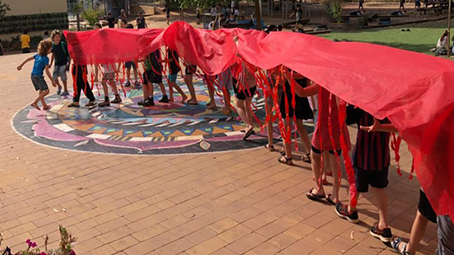
Making a dragon
To make your very own dragon, you will need a cardboard box, crayons, and some paper: you could cut out holes for your eyes and mouth, add on paper teeth and ears, as well as a cardboard tail. You could even make a family dragon, moving it in tandem – the dragon will only move if you all work together.
Proposed Family Activities:
- The book contains many tales, and need not be read in its entirety in a single sitting, nor in order. You may want to suggest that your child select one fable at a time, and then proceed to read it together, and discuss it. Use the title and illustrations to help you select the story. What were you able to take away from the fable to your own life?
- Every community originated in a different country, and each brought with it fables and tales. Is there a certain story you had heard from your grandfather or grandmother? A tale passed in your family from one generation to the next? You may want to continue this generation chain, and tell it to your child.
- Perhaps you would like to pick a story and act it out. You may enjoy using relevant costumes and props.
- You may want to open an atlas or look for the world map online. Can you find where each story came from? Do you know of any other traditions followed there? Perhaps you know some dishes or outfits characteristic of that country, which you would like to demonstrate to your child through videos or images. Do you know a family who immigrated to Israel from that country?
- You could write your own fable together! Perhaps you would like to begin by thinking of a moral which you would like to convey through the story, and invent a tale that tells it.
- Which stories in this book are your favorite, or your child’s? You may enjoy making an illustrated book of fables your family particularly likes, and finds significant.
Proposed Family Activities:
- You may want to sit and leaf through the book together. Perhaps you would like to ask your child to look for the ten sailors in the illustrations, and try to identify each one using their description. Did you find any of the illustrations funny? You may want to ask your child to tell the story in their own words, according to the order of the illustrations.
- You may want to stop reading at the point where the fisherman sailor chooses to drill a hole in his cabin, and ask your child what they think will happen next. You could suggest that your child draw a picture of the ship filling up with water and fish.
- In the first few pages of the book, the sailors are depicted with a rope connecting them. What do you think binds the sailors together? What connects you to your family? You may want to tell your children about the expression “All the People of Israel are responsible for one another”, and think about how we each contribute to the wellbeing of others.
- Each sailor on the ship has a role to play, and each depends upon the others. You could take a large sheet of paper and draw a family drawing together in which each family member chooses just one color. In order to create a colorful drawing, the entire family must cooperate, each member using one color and coordinating their actions with all the others.
- What sort of story is created when the entire family writes it together, one part after the next? Probably a very amusing one. You may enjoy starting to write a story, stopping after one line, and letting other family members write the rest in turn, adding more directions, and letting the plot evolve.
- Perhaps you might like to put a jigsaw puzzle together as a family. Once you are done, take one piece out. What does the puzzle look like with one piece missing?
- Each of us can contribute to the growth or collapse of a building. You may enjoy playing with blocks, wooden bricks, or magnets, and building a tall tower together. Once it is up, try removing pieces from it without letting it collapse.
Enjoy reading and discussing the book together!
The following story was inspired by the Midrash in Leviticus Rabba 4:6:
Family Activities
- In our story there are things that don’t fit into place, things that are ridiculous and the opposite of what one expects. You can thumb through the pages together, examining the illustrations and discovering these things.
- The children can draw pictures of the grandfather, grandson and the donkey and paste them onto the backs of small magnets. The three characters are invited to set out on a “journey” on the refrigerator door or any oother metal surface. They can take turns, sometimes galloping and sometimes being carried.
- Instead of riding on the donkey, the grandfather and the grandson carry the donkey on their shoulders! Select an object, and use it in a different way than for what it was originally intended. Place a number of household objects with which the children are familiar in a box. Each participant takes out an object and uses it in a way that is different from its intended use.
- Who can keep a straight face? Each person in turn tells the next one: “My donkey, hee-haw,” and tries to get him to laugh. Continue saying this back and forth, faster and faster, until one of you bursts out laughing.
- Grandmother waits at home for Grandfather and the grandson. When they return, she is sure to ask them, “How was your journey?” You and your child can be the grandson and grandfather, and explain in your own words what happened on the way to the city.
- Share funny stories with your child. Think back to funny events that happened to you and share stories from the family lore. Be sure to explain the difference between “laughing at someone” and “laughing with someone”!
Sofma’asehbimachshavatechila (Think before you act)
“Sofma’asehbimachshavatechila” or, “Think before you act,” is an expression taken from the Shabbat hymn “LechaDodi” that Rabbi ShlomoAlkabetz wrote in France about 400 years ago. The hymn tells of G-d’s creating the world in six days with the thought that the Sabbath will arrive at the end of the week and will be the height of the creation.
A person who knows where he wants to go will have an easier time getting there. Is it possible to adopt every suggestion we are offered? How do we know which suggestion is the right one for us?
- When a donkey knows the path he will not stray from it. This is how he brings his rider to his destination in the safest way. Together you’re your child, look at the expression on the donkey’s face throughout the story. What, in your opinion, does he feel on hearing all the advice he receives?
- Each person who passes by gives the grandfather and the grandson advice, and the two become very confused. At the end of the day Grandfather says, “We can’t please everyone.” You can discuss with your child: Who knows us well? Whose advice should we accept? Whose opinion should influence us the least? When should we stand up for our rights and not be drawn into something we know is wrong, on the advice of others?
- Sometimes we feel that what others say is more important than our own inner sense of right and wrong. This is a good opportunity to help your children develop their self-esteem and trust their instincts. The absurd ending of the story illustrates with humor the price of going along with others without giving thought to one’s own beliefs.
- From start to finish: Using toy figurines, you can plan the route of Grandfather, grandson and the donkey with your child. Place pieces of Lego, blocks, or even pillows throughout the room. Before setting out, consider the route together, from the planning stage until the completion of the journey, and move the characters along the way from the stable to the city gate and back home again.
Activities You Can Do at Home
- Discuss together the fox’s behavior: do you think it paid off? Was there some other course of action he might have taken, without going hungry and getting so thin — twice?
- Flip through the book and ask your children to tell you the fable using only the pictures as a guide. Pay special attention to the details the illustrator added – for example, what is the fox dreaming about? What other animals appear in the pictures but not in the story?
- The fox really wanted those grapes and was willing to go to tremendous lengths in order to reach them. You might talk with your children about something they might really want, and about what sort of effort they’d be willing to invest to obtain it. Do you know any other fables? The original story appeared in Midrash Kohelet Rabbah, and was included in Haim Nachman Bialik’s Book of Legends, which anthologized hundreds of fables from the Talmud and Midrash. You can find lots more fables and stories of our sages online: in Hebrew at http://agadastories.org , and in English at http://www.chabad.org/library/article_cdo/aid/112670/jewish/Fables-Parables.htm.
- The fox “stars” in many tales and fables. You might discuss with your children the fox’s sly and clever nature. Do you know any other stories featuring a fox (for example, “The Fox and the Chickens” by Haim N. Bialik, or other fox fables)?
- Your children may act out the story using a doll or stuffed animal. When the skit is finished, you can offer both actors and audience bunches of grapes for refreshment!
Activities in the Family
- Follow the worm to tell the story: A little worm is hiding in the illustrations on each page of the book. It accompanies the flock of chickens on their journey to find food and watches what happens. Look for the worm. (You may give hints to children who have difficulty in finding it.)
You might want to use your finger as a “puppet” that talks to the worm about what it sees. You can even draw a little face on your finger and “befriend” the worm.
- At the end of the story the chicken and the fox meet. Look at the illustrations that depict their encounter. Notice the facial expressions of the chicken and note what happens to the fox’s tail. Taking an idea from comics, cut out six “conversation balloons”. Using a bit of masking tape attach the “balloons” to the illustrations of the chicken and the fox. Inside each balloon write what the chicken said to the fox and what he answered her. (Parents: Use as little masking tape as possible in order to protect the book.)
- We part from the brave chicken as she watches the fox run away. In the distance you can see the flock of chickens. They still don’t know that their little friend has saved their lives! It would be interesting to imagine what they do when they learn what occurred. You can act out the meeting between the wounded chicken and her friends by putting on a puppet show. You can make the puppets from cloth material, from boxes or from drawings cut out and pasted to wooden sticks. You can even include the “hidden worm” as the narrator of the story.
- It is very difficult for the chicken to walk. She can’t even manage to hold a stalk of grain in her beak like the others. But when the fox threatens her, she turns her weakness into strength. This is her “hour”. Tell or draw a true or imagined story about someone who has his or her shining “hour”, an event that changes them from someone who is weak into someone who is strong.
- The chicken has one weak leg. That’s why she needs the help of a crutch. Do you know a person or an animal that has a physical weakness? Discuss with your children what can help those who have trouble moving, hearing or seeing. Look for such examples in your neighborhood (special parking places designated for the handicapped, sign language for the deaf on news programs, floor numbers in an elevator embossed in Braille, etc.).
There are even special bills of money that are particularly suited for people who have difficultly in seeing. Look at two different bills of money of differing denominations. Close your eyes and feel the bills, and you will discover a protruding sign that helps people with poor vision “read” the bills and differentiate between them.
The chickens' "Exodus from Egypt”:
Throughout the story “The Chickens and the Fox”, Bialik provides hints to stories of our forefathers in the Bible:
The flock of chickens leaves its dwelling place during a year of drought and hunger and arrives at a place where there is food. Once they have satisfied their hunger, the leader gathers them together and asks them to quickly organize themselves for their journey homeward. They are going back to their coop. On their way home a fox lays in wait for them. Like Amalek, he doesn’t dare attack the main group of the flock, but aims instead at the weak straggler at the tail end of the camp.
As opposed to the fierce battle in the desert with Amalek, our chicken succeeds in frightening the fox. She does this by telling him that he who plans to harm the “tail of the camp” will lose his own tail. The fox is alarmed by this and flees, and thus the story ends with the chickens winning the day.
Family Activities
The characters described in the stories are often referred to as Our Rabbis, or in Hebrew, Hazal, which is an acronym for Hakhameinu Zikhronam Livrakha – Our Sages of Blessed Memory. After you have read the stories together, you may want to talk about sages and wisdom with your child. How do we classify a person as a “sage”? Who do we define as sages these days? Are we aware of different kinds of wisdom?
Were you already familiar with some of the stories included in this book?
Were you already familiar with some of the stories included in this book? Perhaps you heard them as children, and would like to share with your child who told you these stories, and what you learned from them. Did you enjoy the stories?
Some stories have several versions
Some stories have several versions. Are you familiar with any other version of the stories included in this book (found in Sefer HaAggadah, the Talmud or other sources)? You may want to look for these stories together, and compare them.
The legends of Our Rabbis and Midrashim
The legends of Our Rabbis and Midrashim have been passed down by Jewish communities from one generation to the next, whether in written form or orally. Do you have a story in your family that you heard from your grandfather or grandmother, one that has been passed down throughout the generations? You could continue this generation chain by telling it to your child.
You could ask your child which of the stories included in this book was their favorite
You could ask your child which of the stories included in this book was their favorite. You may want to think of its significance in this day and age together. Which character do you identify with? How would you have reacted in a similar situation?
You may want to choose one of the stories and act it out
You may want to choose one of the stories and act it out. You could even look around the house for relevant costumes and accessories (fabrics, capes, pitchers, etc.).
Do you know any other story told about the characters featured in this book?
Do you know any other story told about the characters featured in this book? This is a wonderful opportunity to equip your child with sayings and proverbs, as well as additional Hazal stories, and throw a “Proverbs and Stories of the Past” event. You may find the Aggadah stories for kids website helpful, or the full version of Shoham Smit’s book, A Treasury of Hebrew Legends for Children. You could also use other Hazal story collections, such as Yocheved Segal’s series entitled Ko Asu Hakhameinu, or Uri Orbach’s Hakhameinu Leyameinu.
Family Activities
- Many things cause Isadora’s morning to be gray and gloomy. Look at the illustrations. Search through them with your children and seek out all the things that are difficult for Isadora and that annoy her. You may ask your children: “Does it ever happen to you that you get up ‘on the wrong side of the bed’? What is most difficult in this kind of morning? How do you respond when it happens?”
- Isadora isn’t alone during her day. A small goose accompanies her throughout the entire story! You may want to tell your children about the help that you receive from friends or from family members whenever you are in a bad mood, and suggest that they give thought to who accompanies and helps them to “sweeten” difficult situations.
- Isadora gathers up her gloomy morning and transforms the difficulties into a cake. You, too, can prepare a cake, and sweeten it even more by adding chocolate sprinkles, raisins or candies. You may want to relate to all the sweet additions as symbols of difficult things in the children’s lives, thereby demonstrating the expression “Me’az yatza matok” (Out of the strong came sweetness).
- Isadora is very active. She dances, plucks, bakes, and in the end eats the entire cake! You and your children are invited to make a list of ten ways to overcome a bad mood. You can prepare an illustrated list together and to hang it in a convenient place, as a reminder whenever the need arises.
- Little by little the illustrations in the story change from black to gray to pink. You might explain to the children the special symbolism of various colors. For example, the color pink symbolizes happiness and being positive. It would be fun to prepare some “rose-colored glasses” together from construction paper and rose-colored cellophane. Put them on and see how everything looks different!
- What do you think: Do you and your children think that eating the entire cake was a good idea?
- You and your children may want to invent a different ending for the story. Send your ideas to the Sifriyat Pijama website pj.crunchcart.com, and we’ll post them on the site!
How do we read a book that has no words?
Slowly, and with great pleasure! You can look at each page and enjoy the beautiful illustrations. You may want to tell the story in your own words, taking turns, each of you “reading” one page. Perhaps you would like to look for the picture depicting the lion letting the mouse go and think together: why did the lion choose to let it go? Did it know that one day the mouse would come back and help it?
Acting the story out
You may want to act out the story using puppets: use words one time, and another time, use only pantomime.
Continuing the story
After the mouse releases the lion from the net, the mouse returns to its friends. What do you think it will tell them? You may like to make up a conversation between the mouse and its friends, in which the mouse shares its experiences with them. Do you think they’d be surprised? Will they believe it?
"Every man has his hour…"
The story demonstrates the advantage the mouse has, being small and having sharp teeth. Sometimes the larger creature has the advantage, but other times, the smaller does. You may want to think together of things your child can do that you can’t (like crawl under the sofa to retrieve a fallen object, get into narrow spaces etc.)
Drawing a story
The special illustrations in the book combine pencil, colored pencils and water color techniques. You may want to choose a page that you like and draw the picture using the same techniques. You may also like to look for another book you own and draw the story.
Comparing similar stories
This fable reminds us of the tale of King Solomon and the bee. You may wish to compare the two stories.
Do you know any other fables about animals (for example, The Tortoise and the Hare, or The Fox and the Vineyard)? You may find more Jewish tales and fables on the following website: http://agadastories.org.il/. You’re invited to log on and enjoy the different tales together.
Who would have thought that a lion and a mouse could become friends? Following the book, you may want to discuss friendship, compassion and helping others, returning favors and keeping promises.
Family Activities
The north wind and the sun are depicted in the first illustrations of the book. Each one was given different colors. Which colors were used for the sun? Which for the north wind?
It is difficult to see the wind, but its impact can be felt. You may want to look through the special illustrations of the book together, and look for signs that the wind is blowing. While you are reading the story, is the wind blowing outside? Take a look through the window. Can you “see” the wind?
You may enjoy playing dress-up and acting the story out to your family and friends. What do you think the facial expressions of the north wind and the sun would be like? What voices would they have?
At times, in an effort to get what we want, we too might behave like the north wind; and other times we might behave like the sun. What do we look like in “north wind mode”? What do we look like in “sun mode?”
Can you draw a large, joyful sun together, and hang it up so it would remind us to be kind? You may want to write pleasant, heartwarming words next to each of the sun’s rays on your drawing.
You may enjoy exploring the wind’s impact on different objects together: on the table place a sheet of paper, a stone, a leaf, some cotton-wool, and a spoon. Try to blow on them and move them – which one blew away easily? Which one was impossible to move?
Is it always pleasant in the sunshine and unpleasant in the cold? Which type of weather does each of you prefer? What do we like to do out in the sun, and what do we enjoy when it’s cold out?
The North Wind and the Sun is a fable. Do you know others? You may like to read them together.

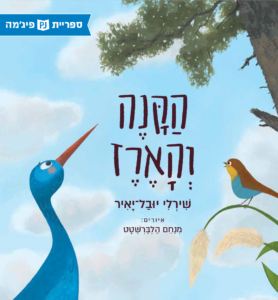 The Reed and the Cedar
The Reed and the Cedar 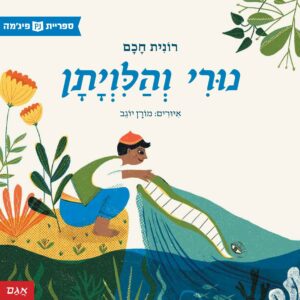 Nuri and the Whale
Nuri and the Whale 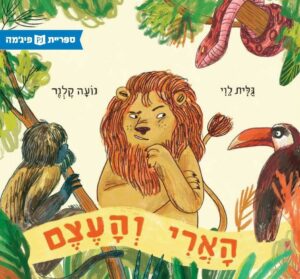 The Lion and the Bone
The Lion and the Bone 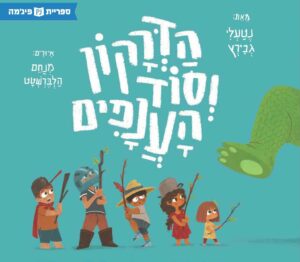 Dragonsticks
Dragonsticks 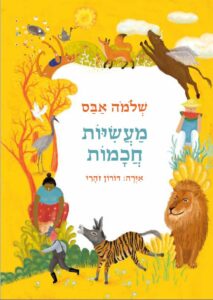 Tales of Wisdom
Tales of Wisdom 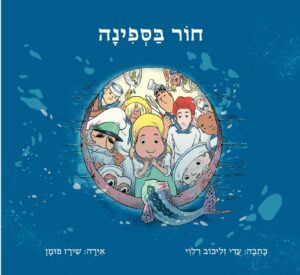 A Hole in the Ship
A Hole in the Ship 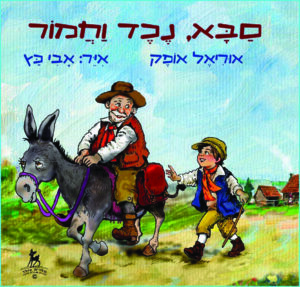 Grandfather, Grandson and a Donkey
Grandfather, Grandson and a Donkey 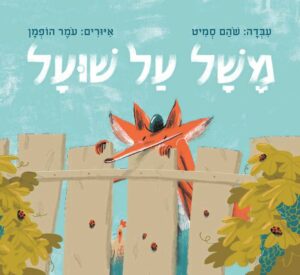 Vineyard
Vineyard 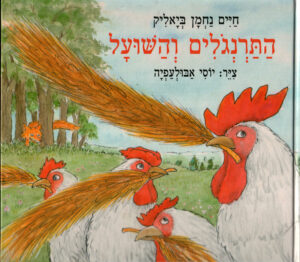 THE CHICKENS AND THE FOX
THE CHICKENS AND THE FOX 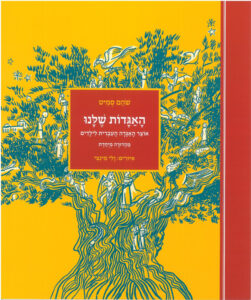 A Treasury of Hebrew Legends for Children
A Treasury of Hebrew Legends for Children 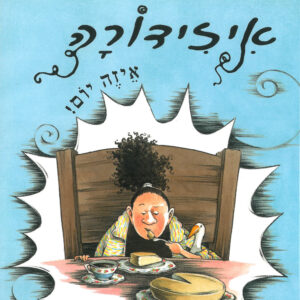 Mrs. Biddlebox In Hebrew, “Isadora, What a Day”
Mrs. Biddlebox In Hebrew, “Isadora, What a Day” 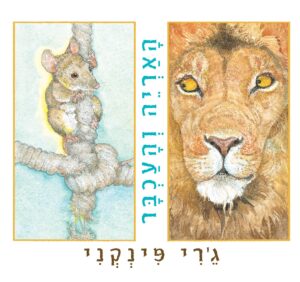 The Lion and the Mouse
The Lion and the Mouse 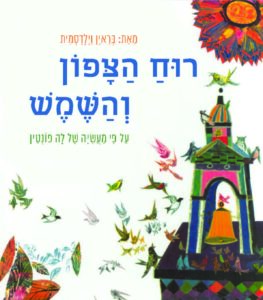 The North Wind and the Sun
The North Wind and the Sun 